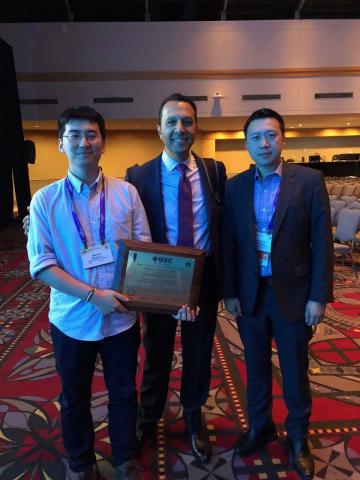ECE Ph.D. student Sensen Li was chosen for the 2018 IEEE Radio Frequency Integrated Circuits Symposium (RFIC) Best Student Paper Award.
Sensen Li was chosen for the 2018 IEEE Radio Frequency Integrated Circuits Symposium (RFIC) Best Student Paper Award. A Ph.D. student in the Georgia Tech School of Electrical and Computer Engineering (ECE), he received the award at the symposium, held on June 10-12 in Philadelphia, Pennsylvania.
The IEEE RFIC is the premier integrated circuits conference focused exclusively on the latest developments in RF, Microwave, and Millimeter Wave Integrated Circuit technology and innovation.
Li’s award-winning paper is entitled "A 28GHz Packaged Chireix Transmitter with Direct On-Antenna Outphasing Load Modulation Achieving 56%/38% PA Efficiency at Peak/6dB Back-Off Output Power.” Joining Li as coauthors on the paper are present or past ECE Ph.D. students Taiyun Chi, Tzu-Yuan Huang, and Huy Thong Nguyen. ECE Assistant Professor Hua Wang is also a co-author; he is the director of the Georgia Tech Electronics and Microsystem (GEMS) Lab and is the advisor for everyone on this research team.
In this paper, the team proposed and demonstrated a packaged 28GHz Chireix outphasing transmitter (TX) for power amplifier (PA) efficiency enhancement at peak and back-off output power (PBO). It utilizes a novel, high-efficiency dual-feed loop antenna (DLA)-based non-isolating power combiner to realize direct on-antenna power combining, and more importantly, outphasing active load modulation. The proposed Chireix TX contains two phase-shifted sub-TXs simultaneously driving a DLA on package. The TX chips are implemented in a 45nm CMOS SOI process and integrated with the DLA by flip-chip packaging.
This Chireix outphasing TX design sets the new world record of energy efficiency among all reported silicon-based power amplifiers and transmitters in the K-band and Ka-band frequency range. This 28GHz TX system could replace many types of transmitters in wireless mobile devices, base stations, and infrastructure links in data centers, in particular for mm-Wave 5G MIMO applications.
Over the past several years, the GEMS team has been working on merging antenna and electronics to substantially boost energy and spectral efficiency of wireless front-end systems. Merging these two disciplines will enable researchers to break through many existing fundamental or practical limits and open a completely new paradigm for future wireless front-end designs. This paper is another proof-of-concept example of such a new design concept.
The work described in this paper is sponsored by Intel Corporation and the U.S. Army Research Office (ARO).
Photo caption: Pictured (left to right) at the 2018 IEEE RFIC Student Best Paper Award Ceremony: Sensen Li (1st Author), Dr. Walid Ali-Ahmad (Facebook, Conference General Chair of 2018 IEEE RFIC), and ECE Assistant Professor Hua Wang.
